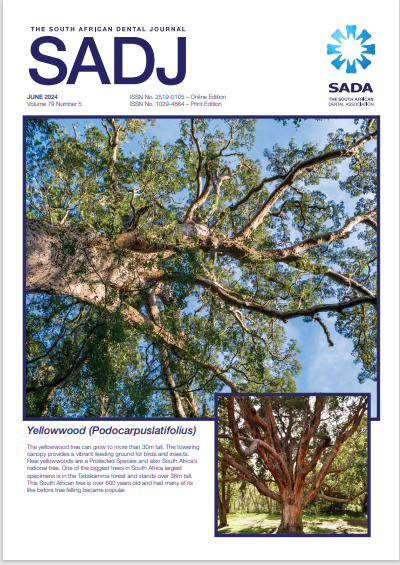Ethical considerations for artificial intelligence in dentistry
DOI:
https://doi.org/10.17159/sadj.v79i05.18355Keywords:
Artificial intelligence, ethics, dentistry, autonomy, treatment, diagnosisAbstract
The incorporation of artificial intelligence (AI) is accelerating in the dental field and even patients are catching on to the trend. There is a form of perceived pressure mounting on practitioners to incorporate modern dental equipment and online services to accelerate treatment time or supplement the diagnosis with visual treatment planning. Many of these applications utilise AI as part of the software to process the inserted data. The use of these products in practice presents various ethical dilemmas the clinician would need to mitigate. Practitioners who own or are considering adding applications and equipment that are AI-based to their treatment
repertoire have an ethical and legal responsibility to ensure that the best interest and safety of the patient are observed. Patient autonomy and protection of all information become a paramount consideration over and above improving profit or personal gain. By no means could the ethical dilemmas in this communication be exhausted, as the rapid AI innovation and the dynamic nature of technological advances have the potential to raise even more debate. As a fraternity, we need to be vigilant and remain grounded with the basic ethical principles underpinned by autonomy, patient confidentiality/ privacy and the practitioner-patient relationship.
Downloads
References
van den Heuvel M. WHO Offers Recommendations for AI Guidelines in Healthcare. 2023; [cited 2024 01/04]. Available from: https://www.medscape. com/viewarticle/998216?ecd=mkm ret 231111 mscpmrk-OUS IntStories etid6040496&uac=208239MR&impID=6040496
Ayad N, Schwendicke F, Krois J, van den Bosch S, Bergé S, Bohner L, Hanisch M, Vinayahalingam S. Patients’ perspectives on the use of artificial intelligence in dentistry: a regional survey. Head Face Med. 2023; 19(1): 23 DOI: https://doi.org/10.1186/s13005-023-00368-z
Health Professions Council of South Africa. Guidelines for good practice in the health care professions. Ethical and Professional Rules of the Health Professions Council of South Africa. Government Gazette R717/2006 Booklet 2. Professional Conduct & Ethics [Internet] 2008. Available from: http://www.hpcsa.co.za/conduct/Ethi
Morris ZS, Wooding S, Grant J. The answer is 17 years, what is the question: understanding time lags in translational research. JR Soc Med. 2011; 104(12):510-20 DOI: https://doi.org/10.1258/jrsm.2011.110180
Hofmann B. Is there a technological imperative in health care? Int J Technol Assess Health Care. 2002; 18(3): 675-89 DOI: https://doi.org/10.1017/S0266462302000491
Hosny A, Parmar C, Quackenbush J, Schwartz LH, Aerts HJWL. Artificial intelligence in radiology. Nature reviews. Cancer. 2018; 18(8): 500-10 DOI: https://doi.org/10.1038/s41568-018-0016-5
Health Professions Council of South Africa. Ethical guidelines for good practice in the health care professions – Protecting the Public and Guiding the Professions in the Health Care Professions [Internet]. HPCSA; 1-335. Available from https://www.hpcsa.co.za/Uploads/ Professional_Practice/Ethics_Booklet.pdf
Huang YK, Hsu LP, Chang YC. Artificial intelligence in clinical dentistry: The potentially negative impacts and future actions. Journal of dental sciences. 2022; 17(4): 1817-18 DOI: https://doi.org/10.1016/j.jds.2022.07.013
Health Professions Council of South Africa. Health Professions Act, 1974. Regulations defining the scope of the Profession of Dentistry. Government Gazette No. 31958 R238/2009. [Internet] Available from: https://www.gov.za/sites/default/files/gcis_document /201409/319582389039.pdf
Brady AP, Allen B, Chong J, Kotter E, Kottler N, Mongan J, Oakden-Rayner L, Pinto Dos Santos D, Tang A, Wald C, Slavotinek J. Developing, Purchasing, Implementing and Monitoring AI Tools in Radiology: Practical Considerations. A Multi-Society Statement From the ACR, CAR, ESR, RANZCR & RSNA. Journal of the American College of Radiology. JACR. 2024; S1546-1440(23): 01020-7 DOI: https://doi.org/10.1016/j.jacr.2023.12.005
Pethani F. Promises and perils of artificial intelligence in dentistry. Aust. Dent. J. 2021; 66(2): 124-35 DOI: https://doi.org/10.1111/adj.12812
Maart R, Mulder R, Khan S. COVID-19 in dentistry – Ethical considerations. South African Dental Journal. 2020; 75(7): 396-99 DOI: https://doi.org/10.17159/2519-0105/2020/v75no7a10
Downloads
Published
Issue
Section
License

This work is licensed under a Creative Commons Attribution-NonCommercial 4.0 International License.






.png)